Chicken wings are a staple in kitchens and at gatherings, prized for their flavor, versatility, and ability to be dressed up with a wide variety of seasonings. However, understanding how to handle, cook, and enjoy raw chicken wings safely is essential. This guide covers everything you need to know—from safety tips to delicious recipes—to make the most of this popular ingredient. Let’s dive into the essentials of chicken wings raw!
What Makes Chicken Wings Versatile?
Nutritional Value of Chicken Wings
Raw chicken wings are not just a delicious treat; they pack a nutritional punch. These wings are a good source of high-quality protein, essential for muscle building and repair. A single serving of raw chicken wings contains about 13 grams of protein, along with important vitamins like B6 and B12, which support brain health and energy production.
Notably, they’re also a source of healthy fats when prepared without excess oil. However, they can be high in cholesterol, so it’s best to consume them in moderation as part of a balanced diet.
Creative Ways to Use Chicken Wings
Chicken wings raw are a favorite for a reason—they’re incredibly versatile. Home cooks and professional chefs alike use them as a canvas for a wide variety of flavors. Raw wings are commonly:
- Marinated in zesty sauces like teriyaki, barbecue, or buffalo for a flavor infusion.
- Coated in dry rubs, featuring spices such as paprika, garlic powder, and cayenne for a smoky kick.
- Baked, grilled, or fried to achieve their signature crispy skin and juicy interior.
Whether you’re hosting game night or prepping a weeknight dinner, raw chicken wings can transform into mouthwatering creations that leave everyone asking for seconds.
Safety Guidelines for Handling Chicken Wings
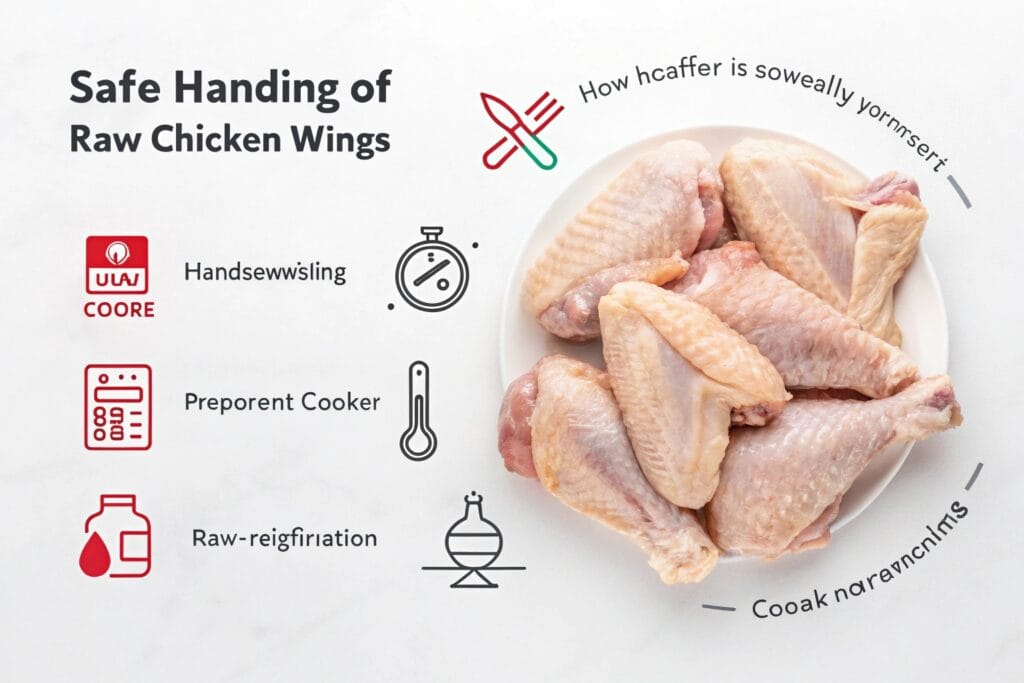
Risks of Eating Undercooked Chicken
Eating undercooked chicken wings can lead to serious health issues. Raw or partially cooked chicken often harbors harmful bacteria like Salmonella and Campylobacter, which can cause foodborne illnesses. Symptoms such as nausea, vomiting, and diarrhea may appear within hours of consumption. To avoid these risks, always cook chicken wings raw to an internal temperature of 165°F (75°C).
Interestingly, some people may think freezing kills bacteria, but it doesn’t—it only slows bacterial growth. That’s why proper handling is just as crucial as thorough cooking when working with raw chicken wings.
How to Store and Handle Chicken Wings Safely
Keeping raw chicken wings safe starts with proper storage. Always refrigerate wings at 40°F (4°C) or below and use them within 1-2 days. If you’re not cooking them soon, freeze them at 0°F (-18°C) to maintain quality and safety for up to six months.
When handling chicken wings raw, avoid cross-contamination by using separate cutting boards and utensils for raw and cooked food. Wash your hands, knives, and surfaces with hot, soapy water immediately after use. A small slip-up, like touching raw wings and then handling vegetables, can spread harmful bacteria.
How to Tell if Chicken Wings Are Spoiled
Knowing how to spot spoiled chicken wings raw can save you from potential illness. Look for these warning signs:
- Odd Smell: A sour or ammonia-like odor indicates spoilage.
- Slimy Texture: A sticky or slimy feel is a red flag.
- Color Changes: If the wings appear gray or green instead of pink, it’s time to toss them.
When in doubt, discard questionable chicken wings to avoid taking unnecessary risks.
Delicious Ways to Cook Chicken Wings
Baking Chicken Wings to Perfection
Baking is a popular way to prepare chicken wings raw. Preheat your oven to 400°F (200°C), then arrange the wings on a baking sheet lined with parchment paper. This method yields crispy skin without the need for deep frying.
For extra crispiness, pat the wings dry before baking and brush them lightly with oil. Flip the wings halfway through cooking, and bake for 40-45 minutes until golden brown and fully cooked.
Crisping Up Chicken Wings in an Air Fryer
Air fryers are game-changers when it comes to raw chicken wings. They achieve that perfect crispiness with minimal oil. To start, preheat your air fryer to 375°F (190°C). Arrange the wings in a single layer in the basket, ensuring they don’t overlap.
Cook for 25-30 minutes, shaking the basket halfway through for even browning. Once the wings reach 165°F internally, they’re ready to serve. Bonus tip: Toss the wings in sauce after cooking to maintain their crispy exterior.
Grilling Tips for Delicious Chicken Wings
Grilling raw chicken wings is a great way to infuse smoky flavors. Begin by preheating the grill to medium heat (about 350°F/175°C). Lightly oil the grates to prevent sticking.
Place the wings on the grill, turning them every 5-7 minutes for even cooking. Grill for 20-25 minutes or until the internal temperature hits 165°F. For extra flavor, brush the wings with barbecue sauce during the last 5 minutes of grilling.
Broiling Chicken Wings: An Easy Guide
Broiling is another quick and flavorful method to cook chicken wings raw. Set your oven’s broiler to high and position the rack 6-8 inches from the heating element.
Arrange the wings on a broiler-safe pan and cook for 10-12 minutes on each side. Keep a close eye to prevent burning. Once done, the wings should be golden, crispy, and fully cooked.
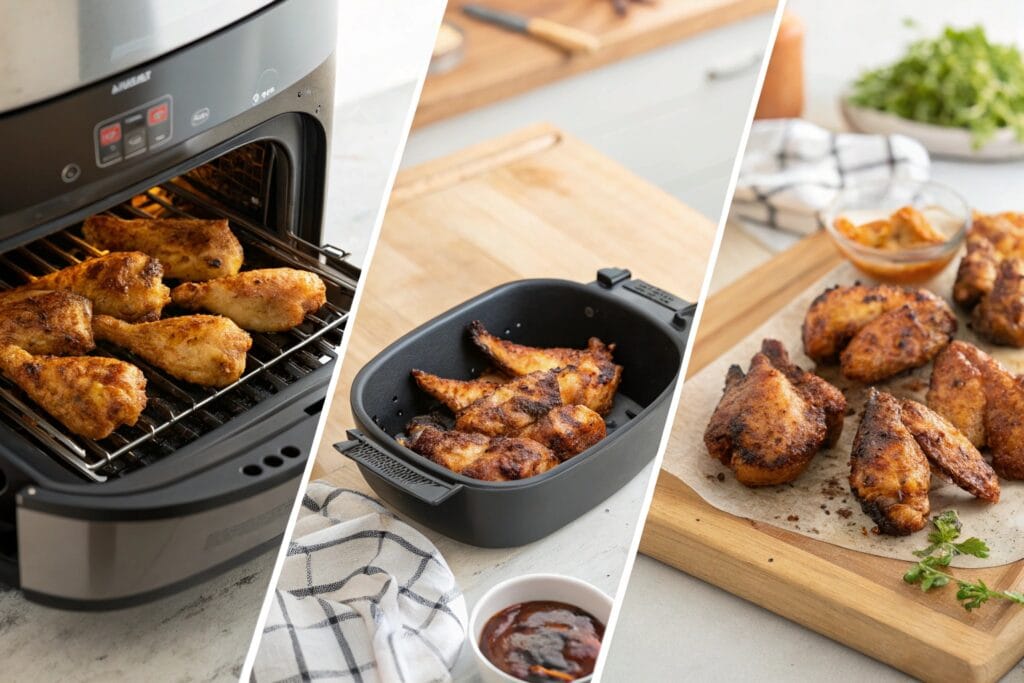
How to Add Flavor to Your Chicken Wings
Best Marinades for Flavorful Chicken Wings
Marinating these wings is a fantastic way to infuse them with rich flavors. A well-balanced marinade typically consists of oil, acid, and seasonings. For instance, combining olive oil with lemon juice and minced garlic creates a simple yet flavorful base. It’s essential to marinate the wings for at least 30 minutes to allow the flavors to penetrate the meat. However, avoid marinating for more than 24 hours, as the acid can begin to break down the meat’s texture.
Using Dry Rubs to Elevate Chicken Wing Flavor
Dry rubs offer a quick and effective method to season these wings. A typical dry rub might include smoked paprika, garlic powder, onion powder, chili powder, and a touch of brown sugar for balance. To apply, pat the wings dry and generously coat them with the spice mixture. This technique not only adds depth of flavor but also contributes to a crispy exterior when cooked.
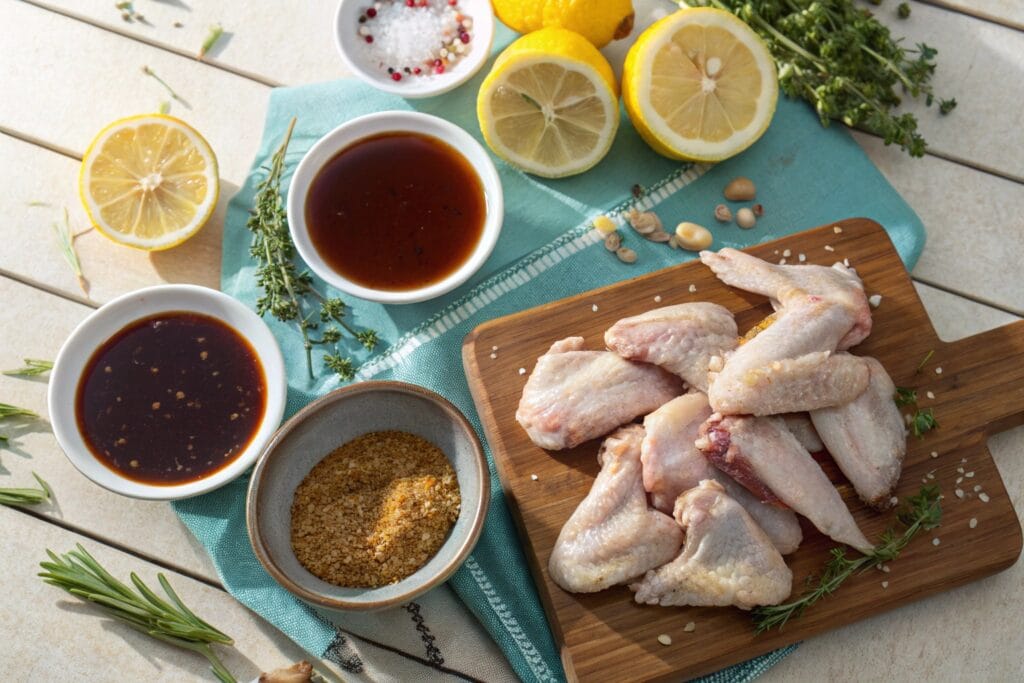
Popular Recipes Using Raw Chicken Wings
Classic Buffalo Chicken Wings Recipe
Buffalo chicken wings are a crowd favorite for their tangy, spicy flavor. Start with chicken wings raw and pat them dry with paper towels for maximum crispiness. Preheat your oven to 400°F (200°C) or set your air fryer to 375°F (190°C).
For the sauce, combine hot sauce, melted butter, and a dash of garlic powder in a saucepan over low heat. While the sauce warms, toss the wings in a light coating of oil and bake or fry until golden and crispy. Once done, immediately toss the hot wings in the prepared buffalo sauce to ensure even coating. Serve with celery sticks and ranch or blue cheese dressing on the side for a perfect pairing.
Honey Garlic Chicken Wings Recipe
Honey garlic chicken wings offer a sweet and savory twist that’s hard to resist. To start, marinate raw chicken wings in a mixture of soy sauce, honey, minced garlic, and a touch of ginger for at least 30 minutes. Preheat your oven or air fryer while the wings absorb the flavors.
Bake or fry the wings until cooked through, then brush them generously with the reserved marinade. To create a sticky glaze, simmer the remaining marinade in a saucepan until it thickens, then coat the wings just before serving. Garnish with sesame seeds and chopped green onions for an extra touch of flavor.
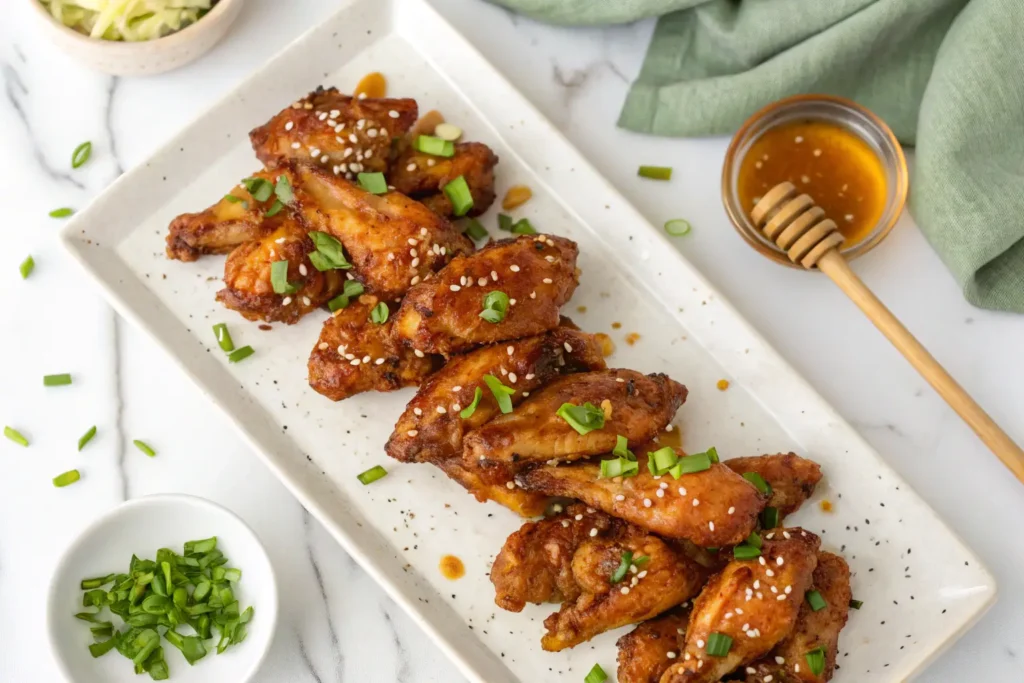
Spicy Korean Chicken Wings Recipe
For a bold, spicy kick, try making Korean-style chicken wings. Start by marinating these wings in a mix of gochujang (Korean chili paste), soy sauce, honey, garlic, and ginger for at least one hour. This blend of sweet, savory, and spicy flavors creates a mouthwatering glaze.
Once marinated, bake or fry the wings until crispy and fully cooked. While they’re cooking, prepare a sauce using the same marinade base but heat it in a saucepan until it thickens. Toss the cooked wings in the sauce, ensuring each piece is well-coated. Garnish with sesame seeds and chopped scallions for a traditional Korean finish.
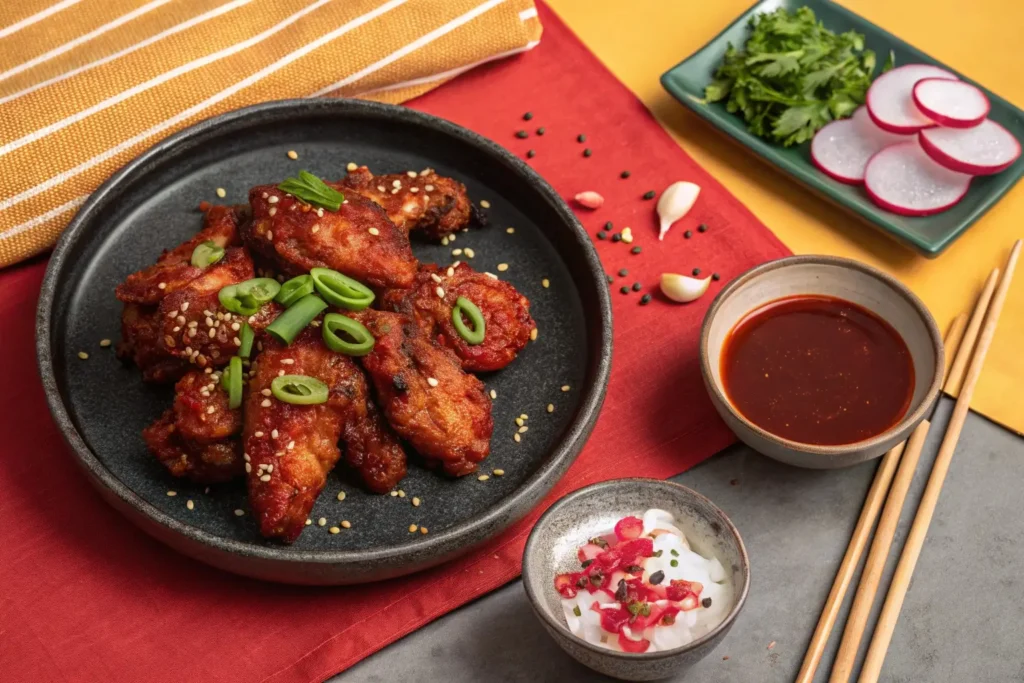
Lemon Pepper Chicken Wings Recipe
Lemon pepper chicken wings are perfect for those who love tangy and zesty flavors. To prepare, coat these wings with a mixture of olive oil, fresh lemon juice, lemon zest, and cracked black pepper. Let them marinate for 30 minutes to enhance the citrusy flavor.
Bake or air fry the wings until crispy and golden. For an extra layer of flavor, sprinkle more lemon zest and cracked pepper right after cooking. Serve with a side of ranch or a lemon wedge to elevate the freshness.
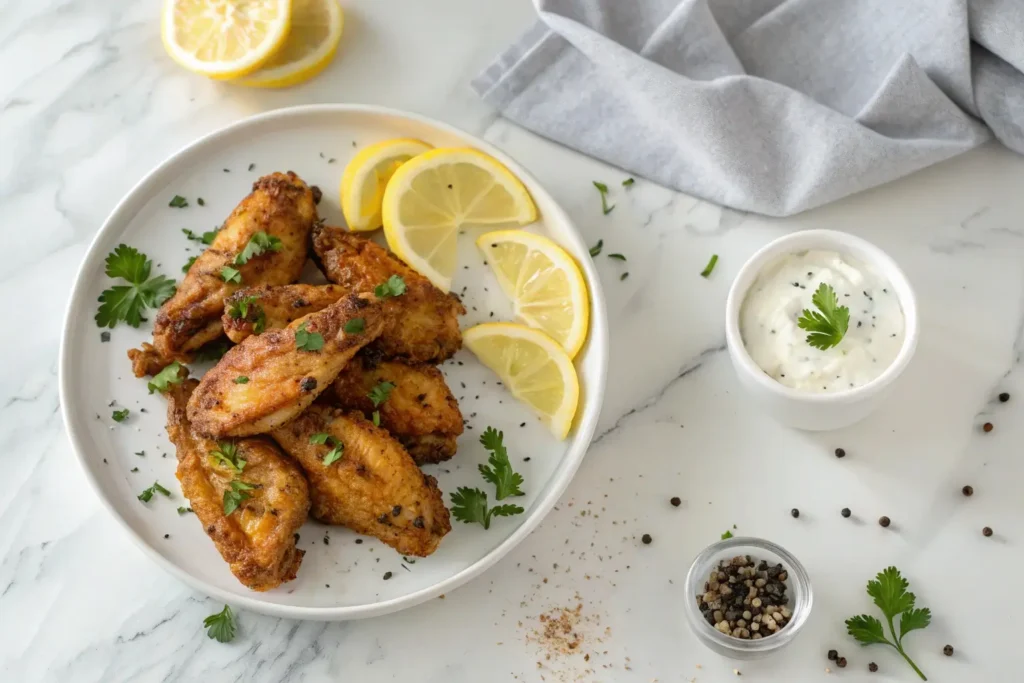
Sticky BBQ Chicken Wings Recipe
Sticky BBQ chicken wings are a timeless classic. Begin by seasoning raw chicken wings with salt, pepper, and a touch of smoked paprika. Bake or grill the wings until they are nearly done. Meanwhile, prepare a BBQ glaze by combining your favorite barbecue sauce with a splash of honey and a dash of hot sauce for a sweet and spicy kick.
Brush the glaze generously over the wings during the last 5-10 minutes of cooking, allowing the sauce to caramelize. Serve these sticky delights with coleslaw or potato wedges for a complete meal.
FAQs
Can You Eat Raw Chicken Wings?
No, it is not safe to eat they. Raw chicken often contains harmful bacteria like Salmonella and Campylobacter that can cause serious foodborne illnesses. Consuming raw or undercooked chicken can lead to symptoms like nausea, diarrhea, vomiting, and fever. To avoid these risks, always cook chicken wings to an internal temperature of 165°F (74°C), ensuring that they are safe to eat.
Is It Okay to Eat Pink Chicken Wings?
A slight pink color in chicken wings doesn’t always mean they are undercooked. The pink hue can sometimes come from the way the chicken was processed or cooked (e.g., smoking or grilling can give a pink tint). However, the best way to determine doneness is not by color but by using a meat thermometer. Insert it into the thickest part of the wing (avoiding the bone), and if it reads 165°F (74°C), the chicken is safe to eat.
What Is the Best Cooking Method for Wings?
The best cooking method for wings depends on your preferences, but popular methods include:
- Baking: Yields crispy skin with minimal oil. Bake at 400°F (200°C) for 40-45 minutes.
- Air Frying: Delivers crispy wings with less fat. Cook at 375°F (190°C) for 25-30 minutes.
- Grilling: Adds smoky flavor and charred texture. Grill over medium heat for 20-25 minutes.
- Frying: Creates ultra-crispy wings, but it’s less healthy. Deep fry at 375°F (190°C) for 10-12 minutes.
Each method offers unique textures and flavors, so experiment to find your favorite.
How to Tell If Chicken Wings Are Undercooked?
To tell if chicken wings are undercooked, look for these signs:
- Texture: Undercooked chicken will feel rubbery or gelatinous, whereas fully cooked wings will be firm and juicy.
- Color: Raw or undercooked chicken often appears pink or translucent, especially near the bone.
- Juices: Cut into the meat; if the juices run pink or red instead of clear, the chicken isn’t fully cooked.
- Temperature: The most reliable method is using a meat thermometer. If it doesn’t read 165°F (74°C), the wings are undercooked.
When in doubt, cook the wings a little longer to ensure safety and quality.
Conclusion
Chicken wings are not just a delicious treat—they’re a versatile, nutritious, and globally loved dish. From understanding their nutritional profile and handling safety concerns to exploring flavorful marinades and diverse cooking techniques, we’ve covered everything you need to know about them. Whether you prefer the boldness of spicy Korean wings, the tanginess of lemon pepper wings, or the timeless appeal of sticky BBQ wings, there’s a recipe here for every palate.
Preparing chicken wings doesn’t have to be complicated. With the right tips and a bit of creativity, you can turn raw chicken wings into a culinary masterpiece that’s sure to impress family and friends.
What’s your favorite way to cook chicken wings? Share your thoughts or try one of these recipes and let us know how it turned out!

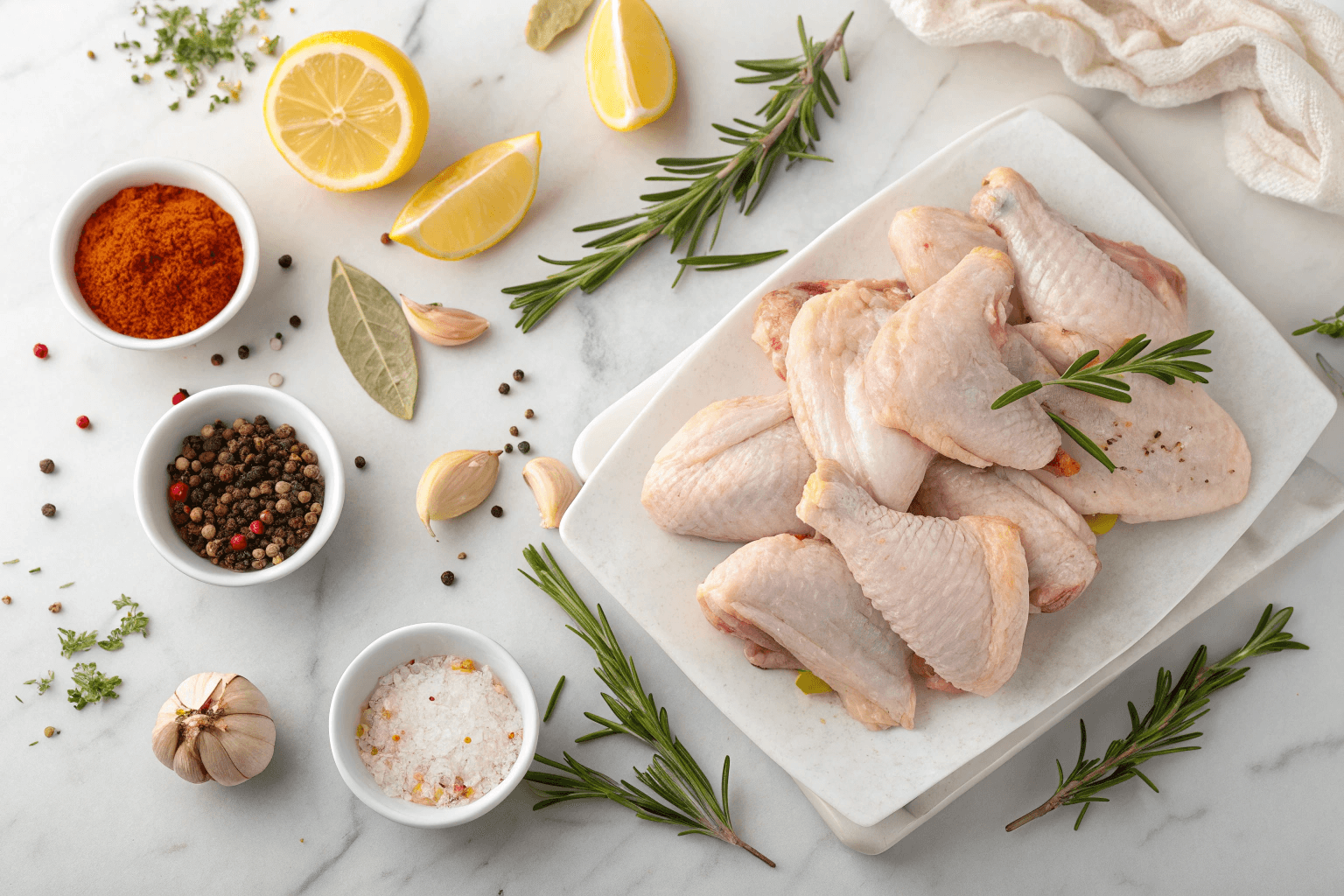
1 thought on “Comprehensive Guide to Raw Chicken Wings”